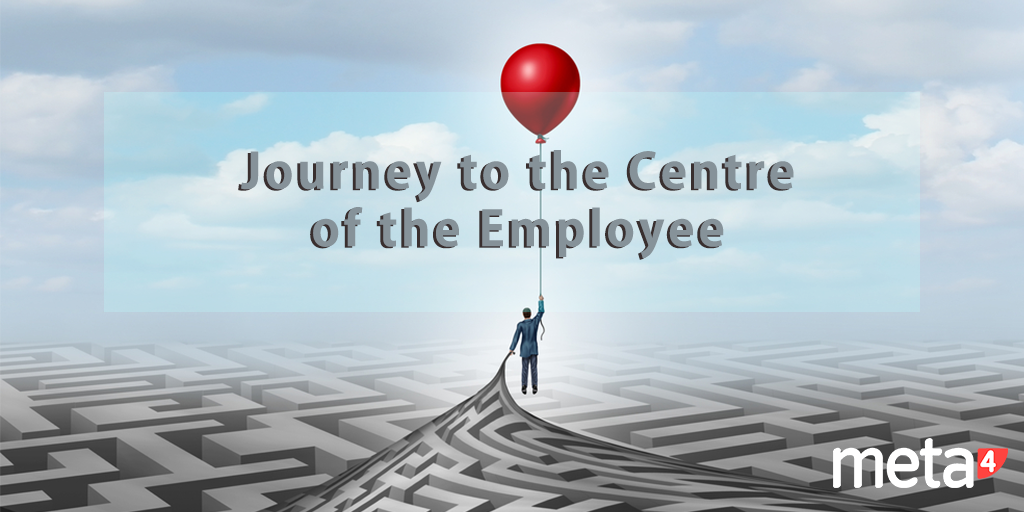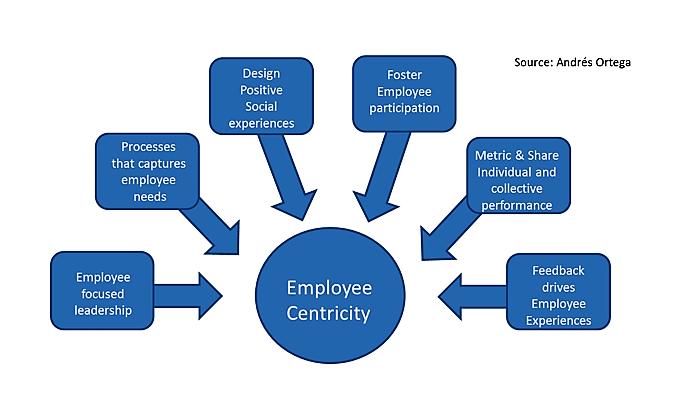A journey to the centre of the employee is a title that Jules Verne himself might have penned. Today it would probably be the riskiest and the most exciting adventure that any company ought to undertake for their people management strategy.
To understand the transcendental nature of this journey to the centre of the employee, also known as employee centricity, it’s essential to come to grips with the intimate relation it has with another equally as passionate adventure that places the customer at the centre of the company’s strategy.
The most advanced organizations in their respective sectors have come to understand that to bring value to the customer while remaining at the crest of the wave is more complicated than ever in the business world. Inevitably in the long run the best way to make the most of the company’s benefits requires the development of a strategy based on customer centricity. This strategy focuses on making sense of developing and commercializing products and services bearing in mind the customer’s true needs and expectations. And I mean just that, the real ones—a nuance that is absolutely overarching.
This is not just about a strategy in marketing terms but also in pure business terms which carry the following implications amongst others:
- Constantly listen to the customer needs and understand them.
- Design product or service experiences with the customer in mind and for the entire customer service life cycle.
- Measure what is really important from the customer’s perspective and not so much by what is interesting to measure.
- Make sure the leadership model systematically positions the customer at the epicentre.
- Use customer feedback for continuously reviewing business processes.
Companies that really want to reach the centres or hearts of their customers must understand this journey in parallel meticulously sets out the plan for yet another adventure…the journey to the centre of the employee.
Overwhelming logic closely intertwines these two adventures. If the products, services and all business operations are in employees’ hands, then they and their behaviour become accountable to making sure that the corporate strategy outdoes the corporate power points to become a tangible reality impacting the business.
The logic should be enough to justify the adventure many companies must embark on without delay, while recognizing that a customer-centric strategy is unfeasible without an employee-centric strategy.
Designing the journey for employee centricity
Evidently there are many aspects a company must take into account in order to undertake this adventure. Besides, it is likely every organization will need specific training adapted to their culture, their industry and their own circumstances. Nevertheless, any business venture that really intends to reach the centre of the employee must tackle the following issues.
Leadership focused on the employee. Undoubtedly the general relationship style between professionals and managers will be the key to ensure the employee is at the epicentre of the model. This model is clearly based on active listening and moving away from inferred expectations. It’s also based on an antagonistic style to command and control such that the manager’s role focuses on putting forward questions rather than giving answers. This leadership model encourages each employee to participate allowing their talent unrestrained freedom to act.
Processes focused on understanding needs, expectations and concerns. A direct spin-off from leadership that allows the employee to grow is the creation of processes that identify the needs and expectations of employees. Such processes transcend the increasingly ineffective occasional performance review or “work atmosphere survey” processes. These processes also make the most of existing social technology to gather direct and instant information on the mood of employees or their degree of satisfaction with the policies and practices affecting them.
Design positive socialization and relationship experiences throughout the life cycle. Designing positive and stimulating experiences throughout the employee’s life cycle within the company starts right from the recruitment and hire phase. However it continues as part of the on-going socialization throughout the employee’s entire life cycle: onboarding, allocation to projects and working groups, changes in activity, remuneration and, of course, upon terminating the relationship with the organization. The entire employee’s life cycle within an organization has multiple critical moments. HR must design positive experiences for each of these so the employee is always at the epicentre of HR management.
Encourage participation. It is really difficult to consolidate a strategy focused on the employee without enabling active and open employee participation within the organizational and cultural framework. The employee must be the protagonist in all facets of management. Therefore, processes to capture their needs as well as the design of experiences across all stages of the entire life cycle must allow employee participation, so they are not mere witnesses but the true protagonists in business processes.
Measure and share individual and collective performance. A strategy focused on the employee must transcend the concept of “internal communication”. It is crucial to encourage employees to contribute to the business and show them how their value is related to achieving or not achieving business performance targets. An employee is at the centre of the strategy when he deeply understands how individual and collective contribution shapes the business, and of course, when this is regularly and consistently transferred through simple processes that generate trust and confidence. In other words, measuring and sharing with employees the impact each one has on the business is a critical factor for an employee-centric strategy to crystallize.
Enriching employee experience through feedback. This factor permeates throughout all of the factors set out previously. This is not only about listening and channelling expectations, interests and concerns. Nor is it even about encouraging participation and designing positive experiences throughout the employee lifecycle. Most of all, it is about exploiting all feedback opinions to constantly review all stakeholder elements in this adventure. Tapping into feedback in a useful way requires giving voice to employees, principally to confer credibility to their opinion by treating them as adults, or as people with sufficient criteria to form opinions on their experiences in the company.
It goes without saying that HR has to play a key role throughout this process. Such an adventure comes with risks and yet once and for all it demonstrates the directly proportional relationship that exists between people management and attaining business goals.
Indeed this is a constant and never-ending process and a one-way trip. This employee centricity adventure, far from being a science fiction novel, represents the most authentic journey for any organization and for all HR professionals to undertake: a journey right to the centre of the employee with no turning back.







